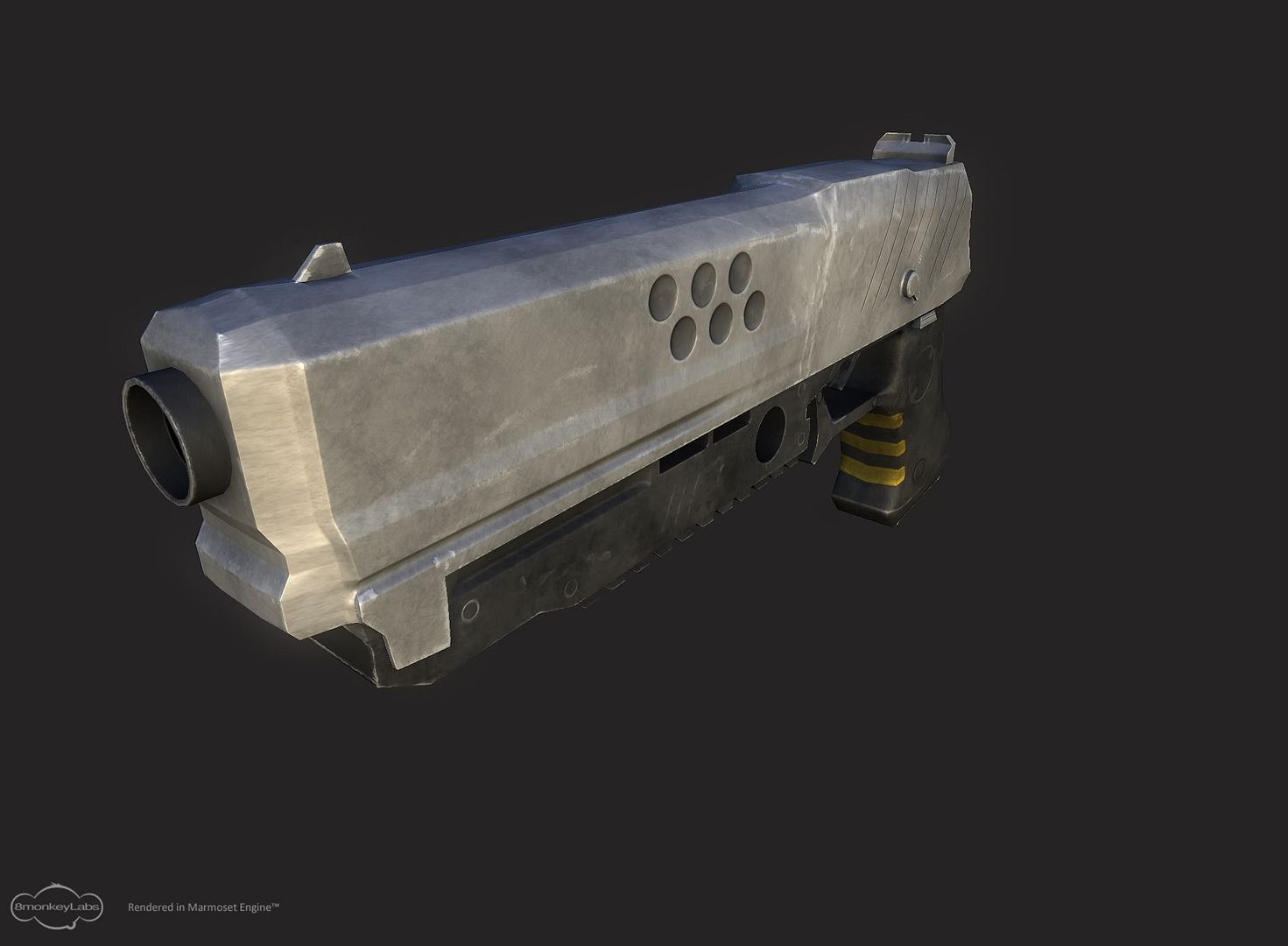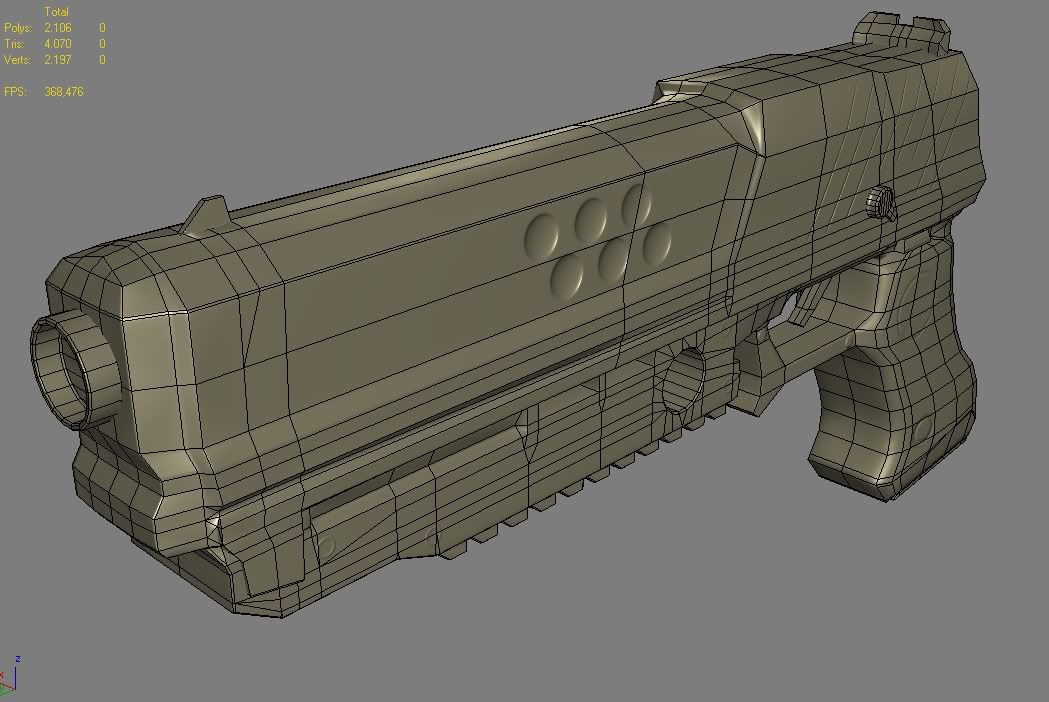The BRAWL² Tournament Challenge has been announced!
It starts May 12, and ends Oct 17. Let's see what you got!
https://polycount.com/discussion/237047/the-brawl²-tournament
It starts May 12, and ends Oct 17. Let's see what you got!
https://polycount.com/discussion/237047/the-brawl²-tournament
Futuristic gun - first next-gen model
Wanted to learn some of the new stuff like highpoly modelling and get better at texturing, so I had a go with a gun. It's based on this concept art by Marco Nelor (I hope it is okay, didn't go for making it the same although I copied some parts)
Modelled this using tips from racer445's tutorial (mostly sub-d, baking and texturing part) I've learnt a lot though I'm aware of tons of normal maps error, mostly from the cage, UV and lowpoly model (damn hard edges)


normal mapped wire:

So... asking for constructive critics, need to learn, pleaaase! nothing is final, mostly the texture, that is not finished. (I'm not sure about some parts like the white metal and the grip... )
nothing is final, mostly the texture, that is not finished. (I'm not sure about some parts like the white metal and the grip... )
Modelled this using tips from racer445's tutorial (mostly sub-d, baking and texturing part) I've learnt a lot though I'm aware of tons of normal maps error, mostly from the cage, UV and lowpoly model (damn hard edges)


normal mapped wire:

So... asking for constructive critics, need to learn, pleaaase!
Replies
Crits:
- Tons of wasted polys.
- One continuous mesh, that won't animate well. Typical guns come in 2-3 main movable parts. You need to research some guns that are of this type, and work out a method for it to move. If you handed this to me to animate I'd stick a 1 bone and 1f in it and call it a paper weight as I handed it back to you.
- The texture looks really high res and some of the details look 1px wide which would get you in all kinds of blurry trouble when and if it gets downsized.
- Seeing the unwrap and the texture break downs would help.
Thanks vig for replying
- Could you tell where these wasted polys are? You mean I could save up some polys, right?
- Right, I had tons of problem with that. At the end I think I nailed the basics but I really would want to learn how guns work so I will research in how parts work
- Yeah, the texture is pretty highres now (4096, because i'm still working in it) though i'm not sure what you mean by 1 pixel detail (I guess I should avoid this?)
- Right, here you go!
And here is the UV where i'm sure I'm full of errors (I think you will see the moved lines that are at the side of the gun... I'm aware of that. I promise it won't happen again.
Also, use more primitives. Seriously, you can cut the basemesh of this gun down a ridiculous amount to what you have right now by just using more seperate parts (and no I don't mean just on your bake).
You want to ask yourself what SOLID PIECES went into putting together this gun. Mechanical modeling is basically a giant puzzle, and optimizing a game mesh is how you figure out how to put those pieces together but still maintain the integrity of the silhouette.
Vig and I have some good tips, put them to use, and show us what you can do.
As far as your texture size, there is realistically no purpose to baking this out and working with a 4096. You are only making more work for yourself working with file sizes that big, and the human eye would have a near impossible time distinguishing any details at that resolution as opposed to a 2048 on your computer screen. Keep in mind that a 4096 is essentially the same pixel density of 16 x 1024 maps, a size which many of the props you see in games on current-gen consoles might not even get.
"1-pixel wide details" essentially means that if this texture went into a game and was scaled down to a reasonable size, those details would be lost due to the scaling down. (One exception to this though is that when baking out normal and AO maps, you will occasionally get better results by baking higher and rescaling in Photoshop as opposed to baking at intended rez) 1 pixel at 4096 res = less than 1 pixel at 1024 res = lost, blurred, pointless to add.
Long story short = make your textures at a realistic game res. A lot of these tutorials out there will tell you to throw 18 4096 textures and 16 material calls on a prop with little-to-no consideration given to realistic game budgets - a skill you will be tested on when looking to get into the gaming industry.
As far as your UVs go, learn to maximize your space. Keeping a good 1-to-1 ratio is all well and good, but there is no rule that says you can't maximize pieces when you have the UV space. My general rules are as such:
- Normalize your UVs to a 1-to-1 ratio and fit as good as possible
- Any UV chunks that are small and can fit somewhere else - scale and make them bigger
- Any cool / interesting / important piece that might need a little extra UV space - scale and move
I would post your high poly first so we can crit that before you get into UVing and texturing. And as an FYI, normal maps have been capable in game hardware for the better part of 10 years now, so I think it is safe to retire the term "next-gen" from your vocabulary simply because it has a normal map on it.A problem I got while modelling this is that I didn't really know what everything was in the starting concept, and it didn't show the basic parts of a gun. I did some basic research on some guns and tried to put the basics in there, for example I wasn't sure about the ejection hole. (Also, look how in the UVs the ejection hole is 'box' while the model is a 'rectangle'... my bad
About the texture, I got told I should always work with double-size textures, meaning I would scale them down, I wasn't sure if I should work at 4096 or at 2048
And lastly with the UV I tried to keep the texel ratio, so them i'm good making the needed pieces bigger, as long as I keep the size ratio? with needed pieces I mean parts that will be seen more ingame.
Here are some shots from the highpoly
And my bad about the next gen thing, I'm a bit antiquated :P
Red can be removed, blue is new topo. There is probably more editing to be done but that's all I have time for. If an edge isn't helping define the shape or there for a really good reason (to enable a tile texture, help smoothing or deformation ect...) then it should probably go.
All game engines read triangles, so its perfectly fine to include a lot of them in your final low poly. you don't need to let edges continue well past their usefulness down the length of the model if they aren't contributing to the overall shape. They don't need to be kept in to conform to some "all quad rule" either. that's mostly for high poly work so its easier to work on and sculpt. (sculpting btw you want roughly even patches not long thin quads).
If you're using 3dsmax, use collapse and remove and it won't mess up your UV layout. Try to avoid using weld as it will mess up your UV's.
The 1px detail I referred to was the fin/scratch like detail on the back of the gun. If you squint at it, it almost disappears. It certainly would if it was downsized. That really should be thickened up.
I also think your texture res is insanely high you could get the same level of detail done, with a 512x512 maybe smaller. I think Unreal clamps textures to 1024 unless you force it go higher. 2048 is reserved for skybox textures I think?
One thing that I wonder, the lowpoly mesh without these edges, would have baked the same normal/lightmap from the highpoly, would be better, worse..:?